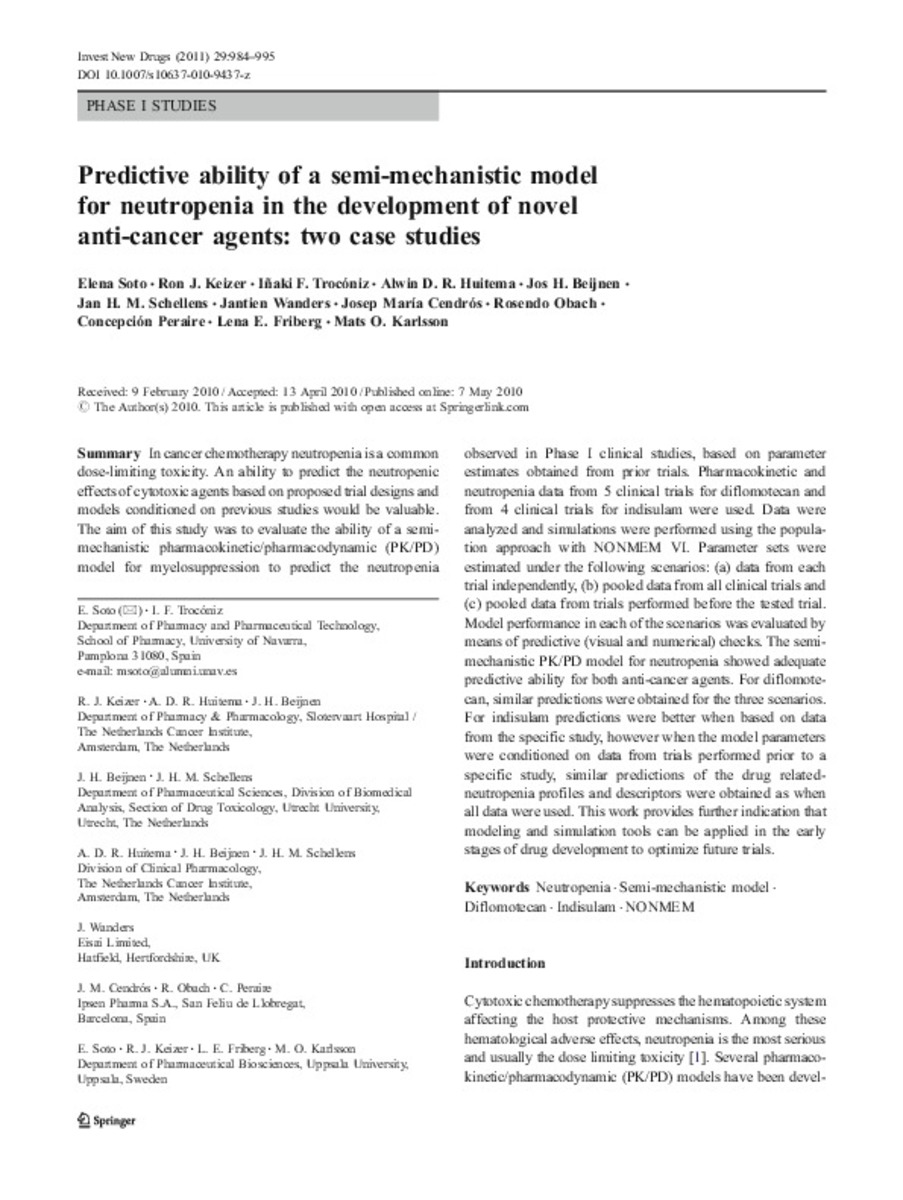Full metadata record
| DC Field | Value | Language |
|---|---|---|
| dc.creator | Soto, E. (Elena) | - |
| dc.creator | Keizer, R. (Ron) | - |
| dc.creator | Troconiz, I.F. (Iñaki F.) | - |
| dc.creator | Huitema, A.D.R (Aldwin D. R.) | - |
| dc.creator | Beijnen, J.H. (Jos H.) | - |
| dc.creator | Schellens, J.H.M (Jan H.M.) | - |
| dc.creator | Wanders, J. (Jantien) | - |
| dc.creator | Cendros, J.M. (Josep Maria) | - |
| dc.creator | Obach, R. (Rosendo) | - |
| dc.creator | Peraire, C. (Concepción) | - |
| dc.creator | Friberg, L. (Lena) | - |
| dc.creator | Karlsson, M.O. (Mats O.) | - |
| dc.date.accessioned | 2012-04-24T07:39:15Z | - |
| dc.date.available | 2012-04-24T07:39:15Z | - |
| dc.date.issued | 2011 | - |
| dc.identifier.citation | Soto E, Keizer RJ, Trocóniz IF, Huitema AD, Beijnen JH, Schellens JH, et al. Predictive ability of a semi-mechanistic model for neutropenia in the development of novel anti-cancer agents: two case studies. Invest New Drugs. 2011 Oct;29(5):984-95. Epub 2010 May 7. | es_ES |
| dc.identifier.issn | 0167-6997 | - |
| dc.identifier.uri | https://hdl.handle.net/10171/21761 | - |
| dc.description.abstract | Abstract In cancer chemotherapy neutropenia is a common dose-limiting toxicity. An ability to predict the neutropenic effects of cytotoxic agents based on proposed trial designs and models conditioned on previous studies would be valuable. The aim of this study was to evaluate the ability of a semi-mechanistic pharmacokinetic/pharmacodynamic (PK/PD) model for myelosuppression to predict the neutropenia observed in Phase I clinical studies, based on parameter estimates obtained from prior trials. Pharmacokinetic and neutropenia data from 5 clinical trials for diflomotecan and from 4 clinical trials for indisulam were used. Data were analyzed and simulations were performed using the population approach with NONMEM VI. Parameter sets were estimated under the following scenarios: (a) data from each trial independently, (b) pooled data from all clinical trials and (c) pooled data from trials performed before the tested trial. Model performance in each of the scenarios was evaluated by means of predictive (visual and numerical) checks. The semi-mechanistic PK/PD model for neutropenia showed adequate predictive ability for both anti-cancer agents. For diflomotecan, similar predictions were obtained for the three scenarios. For indisulam predictions were better when based on data from the specific study, however when the model parameters were conditioned on data from trials performed prior to a specific study, similar predictions of the drug related-neutropenia profiles and descriptors were obtained as when all data were used. This work provides further indication that modeling and simulation tools can be applied in the early stages of drug development to optimize future trials. | es_ES |
| dc.language.iso | eng | es_ES |
| dc.publisher | Boston Springer US | es_ES |
| dc.rights | info:eu-repo/semantics/openAccess | es_ES |
| dc.subject | Cancer chemotherapy | es_ES |
| dc.subject | Neutropenia effects | es_ES |
| dc.subject | Pharmacokinetics | es_ES |
| dc.subject | Diflomotecan | es_ES |
| dc.title | Predictive ability of a semi-mechanistic model for neutropenia in the development of novel anti-cancer agents: two case studies | es_ES |
| dc.type | info:eu-repo/semantics/article | es_ES |
| dc.type.driver | info:eu-repo/semantics/article | es_ES |
| dc.identifier.doi | http://dx.doi.org/10.1007/s10637-010-9437-z | es_ES |
Files in This Item:
Statistics and impact
Items in Dadun are protected by copyright, with all rights reserved, unless otherwise indicated.






